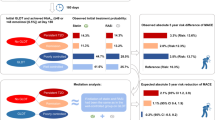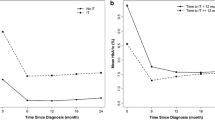Abstract
To study how the targets of glycemic, blood pressure (BP) and lipid control based on the American Diabetes Association (ADA) guidelines have been implemented, and to assess the risk of cardiovascular events (CVD) and mortality in patients with type 1 diabetes stratified by nephropathy (DN) status. A nationally representative cohort of patients with type 1 diabetes (N = 3,151) from the FinnDiane Study were included. CVD and deaths were identified from the national registers. The treatment targets were HbA1C <7 %, BP <140/80 mmHg and LDL cholesterol <2.6 mmol/l. About 63 % of the patients with DN and 34 % of the patients without DN reached none of the targets. With DN, the 10-year cumulative risk of CVD was 17.4 % (95 % CI 11.1–23.2) if BP was on target, 29.9 % (23.0–36.2, P = 0.03) if BP was not on target and 28.4 % (24.9–31.8, P = 0.009) in those who reached none of the targets. The corresponding figures were 3.8 % (2.7–4.8), 4.4 % (2.7–6.2, P = 0.3) and 8.1 % (6.4–9.8, P < 0.0001) for those without DN. In those with DN, the risk of CVD was higher if BP was not on target [hazard ratio (HR) 1.9 (1.1–3.3)], or none of the three targets [HR 2.2 (1.4–3.6)] were reached than if BP was on target. Although the risk of death without DN was higher in those who reached none of the targets (P = 0.003), after adjustment, no differences were observed between the groups. Failure to reach ADA treatment targets is associated with increased risk of mortality and CVD in patients with type 1 diabetes.

Similar content being viewed by others
References
Nathan DM (1993) Long-term complications of diabetes mellitus. N Engl J Med 328:1676–1685
American Diabetes Association (2008) Economic costs of diabetes in the US in 2007. Diabetes Care 31:596–615
American Diabetes Association (2013) Standards of medical care in diabetes—2013. Diabetes Care 36:S11–S66
The Diabetes Control and Complications Trial Research Group (DCCT) (1993) The effect of intensive treatment of diabetes on the development and progression of long-term complications in insulin-dependent diabetes mellitus. N Engl J Med 329:977–986
Diabetes Control and Complications Trial/Epidemiology of Diabetes Interventions and Complications (DCCT/EDIC) Research Group, Nathan DM, Zinman B, Cleary PA et al (2009) Modern-day clinical course of type 1 diabetes mellitus after 30 years’ duration: the diabetes control and complications trial/epidemiology of diabetes interventions and complications and Pittsburgh epidemiology of diabetes complications experience (1983–2005). Arch Intern Med 169:1307–1316
UK prospective diabetes study (UKPDS) group (1998) Intensive blood-glucose control with sulphonylureas or insulin compared with conventional treatment and risk of complications in patients with type 2 diabetes. Lancet 352:837–853
ACCORD Study Group, Cushman WC, Evans GW, Byington RP (2010) Effects of intensive blood-pressure control in type 2 diabetes mellitus. N Engl J Med 362:1575–1585
Laing SP, Swerdlow AJ, Slater SD et al (2003) Mortality from heart disease in a cohort of 23,000 patients with insulin-treated diabetes. Diabetologia 46:760–765
Soedamah-Muthu SS, Chaturvedi N, Witte DR et al (2008) Relationship between risk factors and mortality in type 1 diabetic patients in Europe: the EURODIAB Prospective Complications Study (PCS). Diabetes Care 31:1360–1366
Harjutsalo V, Forsblom C, Groop PH (2011) Time trends in mortality in patients with type 1 diabetes: nationwide population based cohort study. BMJ 343:d5364
Livingstone SJ, Looker HC, Hothersall EJ et al (2012) Risk of cardiovascular disease and total mortality in adults with type 1 diabetes: Scottish registry linkage study. PLoS Med 9:e1001321
Harjutsalo V, Maric-Bilkan C, Forsblom C, Groop PH (2014) Impact of sex and age at onset of diabetes on mortality from ischemic heart disease in patients with type 1 diabetes. Diabetes Care 37:144–148
Bryant W, Greenfield JR, Chisholm DJ, Campbell LV (2006) Diabetes guidelines: easier to preach than to practice? Med J Aust 185:305–309
Resnick HE, Foster GL, Bardsley J, Ratner RE (2006) Achievement of American Diabetes Association clinical practice recommendations among US adults with diabetes, 1999–2002: the National Health and Nutrition Examination Survey. Diabetes Care 29:531–537
Ali MK, Bullard KM, Saaddine JB, Cowie CC, Imperatore G, Gregg EW (2013) Achievement of goals in US diabetes care, 1999–2010. N Engl J Med 368:1613–1624
Friedewald WT, Levy RI, Fredrickson DS (1972) Estimation of the concentration of low-density lipoprotein cholesterol in plasma, without use of the preparative ultracentrifuge. Clin Chem 18:499–502
Levey AS, Stevens LA, Schmid CH et al (2009) CKD-EPI (Chronic Kidney Disease Epidemiology Collaboration). A new equation to estimate glomerular filtration rate. Ann Intern Med 150:604–612
Williams KV, Erbey JR, Becker D, Arslanian S, Orchard TJ (2000) Can clinical factors estimate insulin resistance in type 1 diabetes? Diabetes 49:626–632
DeGuzman PB, Akosah KO, Simpson AG et al (2012) Sub-optimal achievement of guideline-derived lipid goals in management of diabetes patients with atherosclerotic cardiovascular disease, despite high use of evidence-based therapies. Diabetes Vasc Dis Res 9:138–145
Cheung BM, Ong KL, Cherny SS, Sham PC, Tso AW, Lam KS (2006) Diabetes prevalence and therapeutic target achievement in the United States, 1999 to 2006. Am J Med 122:443–453
Maahs DM, Kinney GL, Wadwa P et al (2005) Hypertension prevalence, awareness, treatment, and control in an adult type 1 diabetes population and a comparable general population. Diabetes Care 28:301–306
Beaton SJ, Nag SS, Gunter MJ, Gleeson JM, Sajjan SS, Alexander CM (2004) Adequacy of glycemic, lipid, and blood pressure management for patients with diabetes in a managed care setting. Diabetes Care 27:694–698
Arauz-Pacheco C, Parrott MA, Raskin P (2002) The treatment of hypertension in adult patients with diabetes. Diabetes Care 25:134–147
Hovind P, Rossing P, Tarnow L, Smidt UM, Parving HH (2001) Remission and regression in the nephropathy of type 1 diabetes when blood pressure is controlled aggressively. Kidney Int 60:277–283
Bjorck S, Nyberg G, Mulec H, Granerus G, Herlitz H, Aurell M (1986) Beneficial effects of angiotensin converting enzyme inhibition on renal function in patients with diabetic nephropathy. Br Med J (Clin Res Ed) 293:471–474
Fagard RH (2012) Resistant hypertension. Heart 98:254–261
Calhoun DA, Jones D, Textor S, Goff DC et al (2008) Resistant hypertension: diagnosis, evaluation, and treatment. A scientific statement from the American Heart Association professional education committee of the council for high blood pressure research. Hypertension 51:1403–1419
Persell SD (2011) Prevalence of resistant hypertension in the United States, 2003–2008. Hypertension 57:1076–1080
De Nicola L, Gabbai FB, Agarwal R et al (2013) Prevalence and prognostic role of resistant hypertension in chronic kidney disease patients. J Am Coll Cardiol 61:2461–2467
Lithovius R, Harjutsalo V, Forsblom C, Saraheimo M, Groop PH, On behalf of the FinnDiane Study Group (2014) Antihypertensive treatment and resistant hypertension in patients with type 1 diabetes by stages of diabetic nephropathy. Diabetes Care 37:709–717
Valle T (2010) [Glycaemic control in patients with diabetes in Finland in 2009–2010]. DEHKO-report 2010: 5. Finnish Diabetes Association 2010. Finnish
Waden J, Forsblom C, Thorn LM, Gordin D, Saraheimo M, Groop PH, Finnish Diabetic Nephropathy Study Group (2009) A1C variability predicts incident cardiovascular events, microalbuminuria, and overt diabetic nephropathy in patients with type 1 diabetes. Diabetes 58:2649–2655
Acknowledgments
This research was supported by grants from the Folkhälsan Research Foundation, the Wilhelm and Else Stockmann Foundation, Academy of Finland and the “Liv och Häls” Foundation and The Diabetes Research Foundation. The authors also acknowledge the physicians and nurses at each study center (Supplementary Appendix 1).
Conflict of interest
P.-H. G. has received lecture honorary honorariums from Boehringer Ingelheim, Genzyme, Novartis, Novo Nordisk, MSD, Eli Lilly and Medscape. P.-H. G. is an advisory board member for Boehringer Ingelheim, Eli Lily, Novartis, Abbott and Abbvie. P.-H. G. has received investigator-initiated study grants from Eli Lilly and Roche. M. S. has received lecture fees from Eli Lilly, Medtronic, Novo Nordisk, Roche and Sanofi-Aventis and is an advisory board member of Medtronic in Scandinavia. No other potential conflicts of interest relevant to this article were reported. The funding sources were not involved in the design or conduct of the study.
Human and animal rights
All procedures followed were in accordance with the ethical standards of the responsible committee on human experimentation (institutional and national) and with the Helsinki Declaration of 1975, as revised in 2008.
Informed consent
Informed consent was obtained from all patients for being included in the study.
Author information
Authors and Affiliations
Corresponding author
Additional information
Managed by Massimo Federici.
On behalf of the FinnDiane Study Group.
Electronic supplementary material
Below is the link to the electronic supplementary material.
Rights and permissions
About this article
Cite this article
Lithovius, R., Harjutsalo, V., Forsblom, C. et al. The consequences of failure to achieve targets of guidelines for prevention and treatment of diabetic complications in patients with type 1 diabetes. Acta Diabetol 52, 31–38 (2015). https://doi.org/10.1007/s00592-014-0595-x
Received:
Accepted:
Published:
Issue Date:
DOI: https://doi.org/10.1007/s00592-014-0595-x




